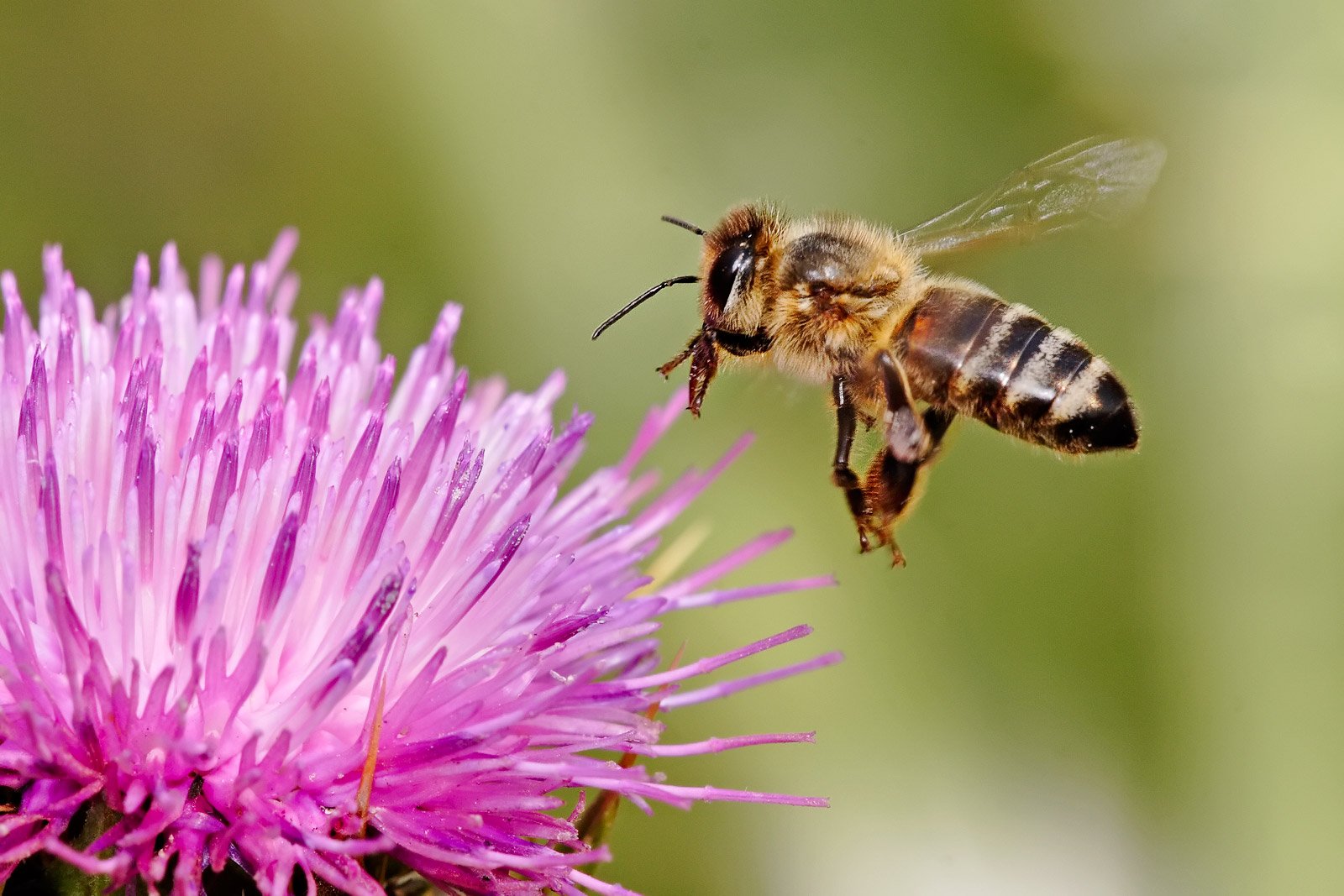
When I first started iGEM I thought that the bees' only purpose was to strike fear into the heart of all humans and stab us with their butt swords. I have since learned that they are an important link in the agricultural industry by: giving us honey, beeswax, and feeding us. They help feed us through pollinating other plants, spreading seeds across fields, and helping our plants survive. For such a small little guy, they really do so much for us and are completely disregarded in that. So welcome to the Ted Talk of Brittany Sauter as I embark upon telling you about how amazing and incredible these little critters are — while I try not to panic due to my huge phobia of bees.
Pollination is not an abstract topic to us. Just recently, when visiting St. Luke's Catholic School, the grade 4 class was talking about pollination, plants, and of course the bee. The bee, in all its majestic form, goes to the plant to collect nectar and, just by chance in the process of getting that nectar, it gets pollen (the seed) on its hind legs (1). Since the bee is a hungry guy, it wants more nectar but not from the same plant. So, it flies away to a new plant to get nectar. In that process of leaving the first plant, flying around randomly, landing on the second plant and getting more nectar; it has pollinated (1). Which is pretty cool, if you ask me!
This entire process of the plant and the bee working together is called co-evolution, which is pretty common. Co-evolution is when two or more species affect each other's evolution, either aiding it or negatively affecting it. In this case, the bees' and flowers' relationship serves as an example of positive co-evolution (2). Now you might be wondering, "How did they co-evolve?" It's simply done by a series of adaptations and specializations. It is a constant rotation between flowers adapting to bees and bees adapting to flowers, which is something that even Darwin noticed. It turns out bees are attracted to plants with bilateral symmetry, the colours blue and yellow, and at manipulating flower parts. Since the plant wants to be pollinated by bees, the plant has selective pressures to favour those adaptations. Flowers influence bees by wanting them to have hairy back legs, a specific body type, and effective pollination. In turn, the bee also has selective pressures favouring those adaptations. This is a cycle, with the two constantly influencing each other to be preferred (3).
Honey bees are quite adaptive since they are able to collect pollen from multiple plants and most of their life is spent collecting pollen, making them super important guys (4). This beneficial relationship between bees and flowers feeds us so without them, life would be not so gouda.
I know right? Pollination is awesome. These two have basically evolved together to feed themselves, help the plant, and we take that to our advantage. So besides bees, what are other ways that pollination happens? Pollination is the act of pollen being moved from the male part (the anther) to the female part (the stigma) of the plant. In summary, pollination is the act of making the next generation of plants; however, the seeds that go to the stigma must be that of the same species. How pollen moves is by a vector, or pollinators, the most common being bees. Other vectors include the wind, water, birds, various insects, bats, and other animals that even graze by flowers. Using pollinators is a method called cross-pollination; however, there is another type called self-pollination where the plant just fertilizes itself (5).
So then, why are bees going extinct if they are co-evolving with plants and helping each other? The answers to that are simple: climate change, insecticides, pesticides, and herbicides. Since these are constantly being sprayed on our agriculture plants, they are affecting the bees' stress levels. Moreover, if one type of pollinator is stressed, the other pollinators could also be affected.
You are probably thinking, "Well maybe only spray the crops with herbicides since the bees are not a plant?" However, the answer isn't that simple. Our research is dealing with an intraparasite called Nosema ceranae and if the bee has an overly high level of this intraparasite and then comes into contact with areas sprayed with herbicides, the herbicides make the bees more susceptible to these toxins and eventually kill them. If you spray the area with insecticides, this will most certainly damage the bees since they are an insect and pesticides harm them (6).
This figure shows the percent of bees dying with either spraying the crops with 0.1% (the recommended amount) of a surfactant called "Boost" or 0.01% of it. Surfactants are chemicals used in herbicides, insecticides, and fungicide sprays (7). If the same chemicals are being used in both herbicides and insecticides then we can't only use herbicides. Like I said above, the answer is not that simple... or is it? We could just stop spraying our crops with damaging chemicals that affect not only the pollinators, wildlife, but also people who are spraying the chemicals on these crops. But that is probably another Brittany Sauter "Ted Talk" to look at in the future.

So there we have it folks, the Brittany Sauter "Ted Talk" on pollination and the bees. We have officially come full circle on how not only bees and plants have co-evolved, but also what is affecting the bees in their efforts to pollinate and influences on them. I hope this was informative to us all and that you look forward to our future blog postings.

References
- https://bees.techno-science.ca/english/bees/pollination/default.php
- https://www.google.com/url?q=https://www.nature.com/subjects/coevolution&sa=D&ust=1561328203384000&usg=AFQjCNFD1QlokC0pH0Y9TRgtXbZt6TF6Eg
- https://www.wnps.org/blog/coevolution-and-pollination
- https://www.otago.ac.nz/genetics/otago038359.pdf
- https://www.fs.fed.us/wildflowers/pollinators/What_is_Pollination/
- https://www.nrdc.org/sites/default/files/bee-deaths-FS.pdf
- Effect of surfactants on honey bee survival. N Z Plant Prot - Scientific Figure on ResearchGate. Available from: https://www.researchgate.net/figure/Honey-bee-mortality-when-sprayed-with-different-amounts-of-two-concentrations-of_fig1_264839364
- Brittany A. S.





0 comments:
Post a Comment